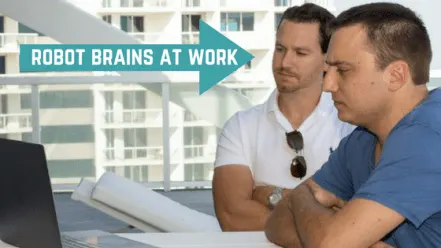Page Speed Doesn’t Just Matter; It’s All That Matters


Eric Hochberger, Mediavine Co-Founder and CEO, still wants you to think like a robot.

Eric and Brad, fixing the internet.
In his knowledge-packed session at our 2017 conference in Charleston, he broke down the nuts and bolts of page speed in a language all us non-developers can understand: PLAIN ENGLISH.
There aren’t many people involved in the digital space who will tell you that page speed doesn’t matter. Anyone who’s ever yelled “just LOAD!” in frustration at a glowing screen or pressed the back button 50 times while trying to read the news on their phone KNOWS that site speed is an important thing.
But many of us non-techies don’t know exactly WHY it matters so much to the people we want to work with (like Google and big brands) or HOW to fix the issues that are making our site slow.
At our conference, Eric broke it all down and gave step-by-step recommendations to jump-start the sometimes overwhelming speed optimization process.
If I mined out and listed all the great nuggets here this post would quickly become tl;dr so I highly recommend you watch the session video. (You can also find it at the bottom of this post.)
As a part of our Mediavine Publishers Conference 2018 (CountdownToCali), we’re revisiting some of our past sessions and checking in with our speakers to see what’s changed since Charleston and looking forward in our industry to 2018.
As a computer engineer, we’re always in that mindset of thinking in terms of computational costs of operations. To the rest of the world, that’s just gibberish.
The reason it’s so important here is because you’re going to be asked to make site changes that might only result in fractions of a second in page speed increase. To a human, you’d think that’s a waste of time. But to your computer, that’s everything. But by the time you’re done, you can be a human again because those changes are going to add up to be noticeable to you and your readers.
I think I may have overly biased my speech toward Google Page Speed Insights, but that’s definitely to prove a point. Not all page speed tools are measuring the right thing. There’s a lot of popular tools out there that web hosts and developers use, but most of them are measuring total page load.
I love Google Page Speed Insights and Web Page Test because those two focus on the most important page speed metric – how quickly the first screen view loads. They also are uniquely the only two tools that Google itself recommends. If you can get good scores on both Google Page Speed Insights and Web Page Test, then you have a fast site in the eyes of readers and Google. What more do you want?
Autoptimize is essential for WordPress sites to move all of their JavaScript and Stylesheets to be asynchronous / deferred, minified and compressed. Without Autoptimize there’s no way to do some of those requirements for a 85%+ Page Speed Insights scores.
The biggest page speed no-no I learned since Charleston that I wished I talked more about were Google Fonts.
Really any non-standard web font is a pretty big hit to page load because you can’t render the first screen view if it has any text that uses that font until you load that font.
Fonts pretty much instantly become a piece of blocking content similar to Stylesheets and JavaScript. Lauren and her team at Once Coupled have some solutions to these using the Above the Fold Optimization plugin, but I’d definitely add custom fonts to my list of no-nos.
At Mediavine, our goal is to make ads suck less. I think in order to do that, we have to continue to do what we can to minimize ads impact on that initial page screen load. We already lazy load most of our ads (read about that here), and only load 1-2 ads at initial page load.
I think our dream is to eventually offer an option to publisher obsessed with page speed to load NO ads at initial page load. It’s asking a lot of our publishers in terms of sacrifice of revenue, but with Mediavine we love to try and find that balance.
Thank you for chatting with me, Eric, and for all the awesome learning. Stay tuned for another 2017 MPC session refresh soon as we count down to Mediavine Publishers Conference 2018. In California. At GOOGLE.
(We might be a little excited.)
Tickets will go on sale on November 15 — save the date!
Stay up to date with the latest from Mediavine
Along with the rest of the world, Mediavine has been watching Russia’s war on Ukraine unfold with horror. Let me state unequivocally, we stand with Ukrainians and anyone else speaking …
 Eric Hochberger
Eric Hochberger
For as long as we can remember, we’ve stressed to our publishers that the key to success with Mediavine, and programmatic advertising in general, is viewability. As its name implies, …
 Eric Hochberger
Eric Hochberger
Updated 8/30/2021 – The Trellis Open Beta is now available to all! Turbocharge your WordPress site and conquer those Core Web Vital scores with the theme built for speed. Learn …